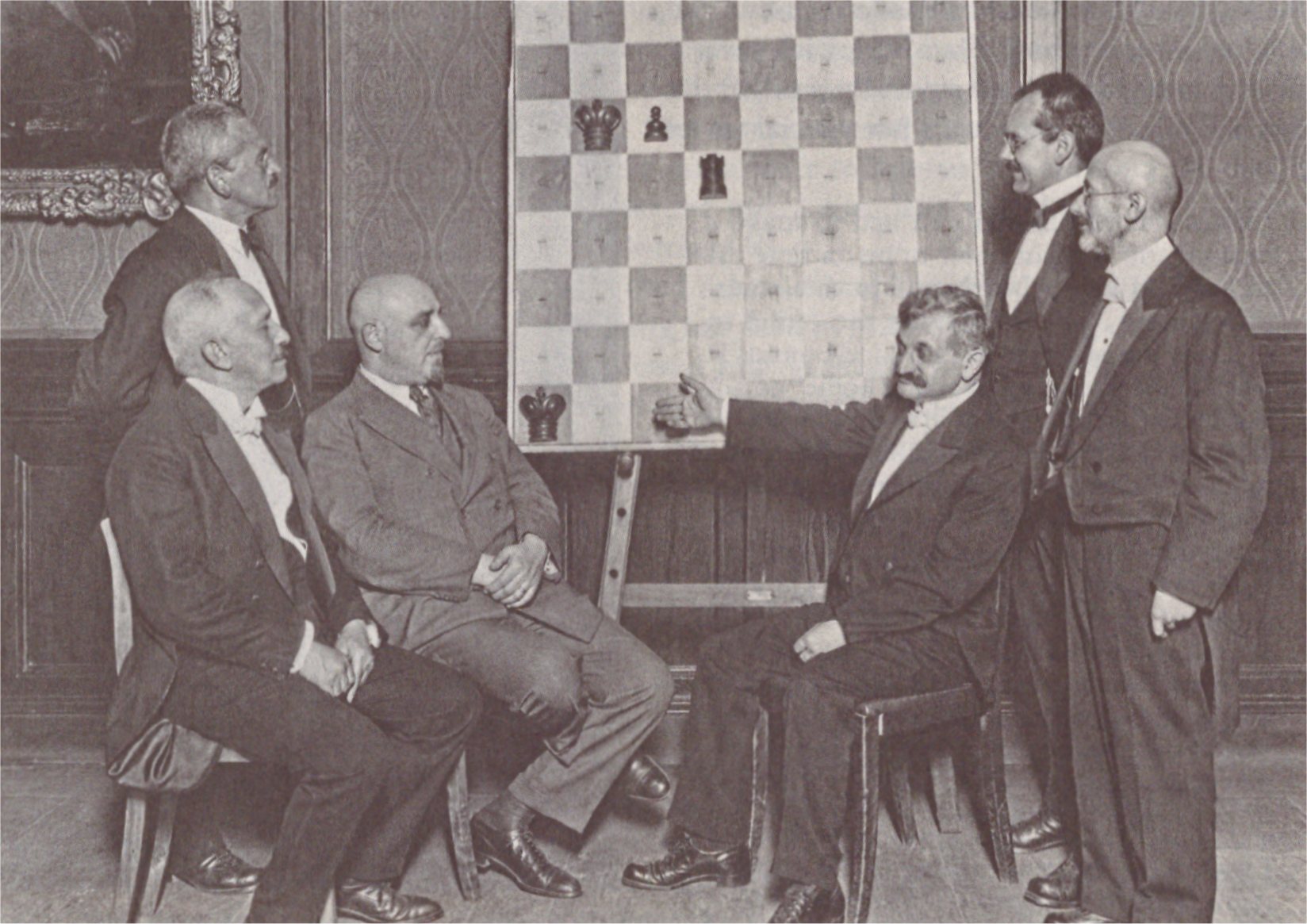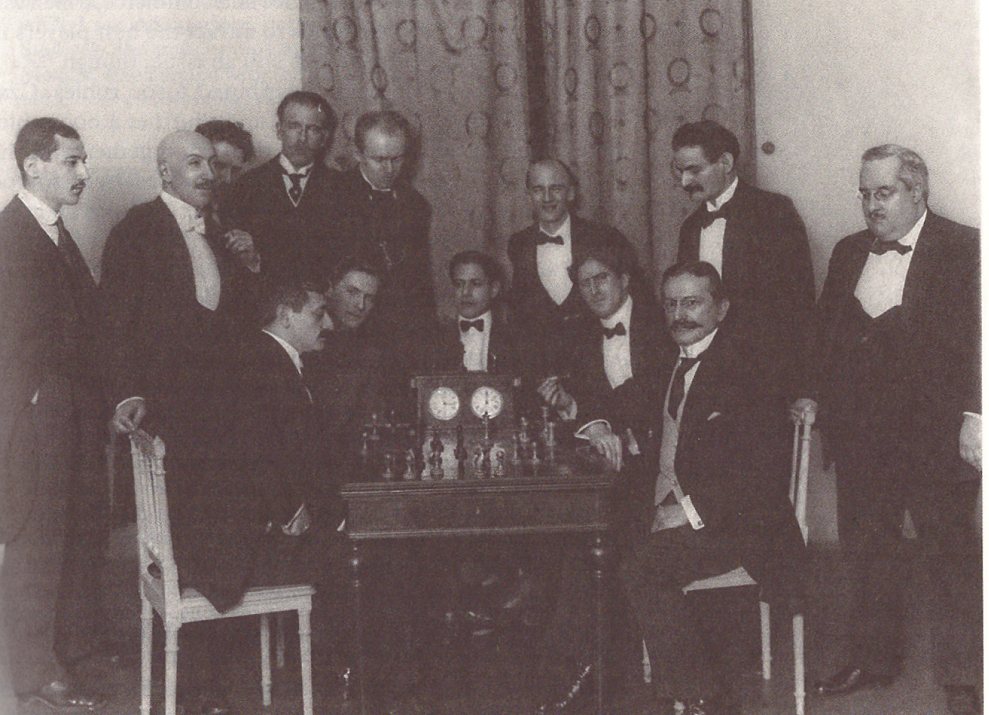In 2015, a large-format Lasker biography was published in German, but it has long been out of print. The new English edition has now been divided into three more manageable volumes and its content has been expanded to include a number of new aspects and insights.
The editors of the biography are the chess historians Richard Forster and Michael Negele and the publisher GM Raj Tischbierek. In each of the three volumes competent authors present essays about various topics and aspects around Emanuel Lasker's life and work.
The name Emanuel Lasker will always be linked with his incredible 27 years reign on the throne of world chess. In 1894, at the age of 25, he had already won the world title from Wilhelm Steinitz and his record number of years on the throne did not end till 1921 when Lasker had to accept the superiority of Jose Raul Capablanca. But not only had the only German world champion so far seen off all challengers for many years, he had also won the greatest tournaments of his age, sometimes with an enormous lead. The fascinating question is, how did he manage that?
The third volume is entitled "Labors and Legacy - Chess, Philosophy, and Psychology" and contains nine chapters on 453 pages plus a 15-page appendix. The volume begins with the third part of the "Biographical Compass" written by Richard Forster. On more than 100 pages it covers the period from the outbreak of the First World War in 1914 to the end of Lasker's life in 1941. The beginning of the First World War meant a dramatic break in Lasker's life. Among other things, he had to discontinue his chess magazine "Der Schachwart" and could not continue his chess column in the New York Evening Post.
As a German patriot, Lasker belonged to a group of scientists who worked on possible improvements to artillery for the Reichsheer. At the beginning of the war, Lasker wrote political columns and gave patriotic lectures to the "Vaterländischer Frauenverein". Later he turned again to more mathematical studies, philosophy and chess. With a few exceptions, the actual chess life, however, had come to a complete standstill due to the war, and after the war it took some time before it could re-form. During the war years, Lasker also lost a large part of his income. Like many others, he had invested his savings in war bonds, but these were worthless after the war.
In 1920 Lasker went to the Netherlands, which became a second home for him. In the meantime Capablanca had resumed negotiations for a World Championship match against Lasker. As is well known, this match took place in Cuba in 1921 but Lasker, who had been world champion for 27 years, abandoned the match prematurely because he was in poor health. However, Lasker was still one of the world's best players, as he proved three years later at the tournament in New York in 1924, where the 57-year-old played rings around the the rest of the world's top players.
Another bitter turning point in Lasker's life came in 1933 when the Nazis came to power. Lasker was in Berlin when Hitler was appointed Chancellor of the Reich. In February 1933 he travelled to Paris without his wife Martha, met a few friends and then went to the Netherlands. He did not return to Germany. Martha Lasker stayed in Berlin, as many of her family members lived there. In the meantime, Lasker's financial situation became worse and worse as the Nazis stopped him from publishing.
In 1934 Lasker left the Netherlands and moved to London. His wife Martha visited him there for a few weeks, but then returned to Berlin. In 1935 Lasker played a tournament in Moscow - Martha accompanied her husband on this trip - and asked Nikolai Krylenko, the head of the Soviet chess section, to give him a permanent residence permit in the Soviet Union for himself and his wife. After the tournament, the Laskers returned once more to their flats in London and Berlin, and Martha liquidated the flat in Berlin. The couple met in Warsaw and then travelled together to Moscow to settle there.
However, living conditions in the Soviet capital were far less pleasant than the Laskers had wished. The former World Champion was cheered - and not only by chess fans - but social life in the Soviet Union under Stalin was completely poisoned by the political atmosphere. The time of show trials and "purges" began, to which Krylenko eventually also fell victim.
Lasker played his last two tournaments in 1936, in Moscow and in Nottingham. In September 1937 Emanuel and Martha Lasker travelled to Chicago to visit their granddaughter and did not return to Moscow but decided to stay in New York, where Lasker died in 1941 in the Mount Sinai Hospital.
Lasker's life is traced in great detail by Richard Forster and illustrated by many contemporary photos that show not only Lasker and his wife in hitherto unknown shots, but also many other people Lasker met on his way, chess players, organisers and other personalities. The carefully edited photos and portraits are also inserted in large numbers in the other chapters and paint a picture of the times.

Lasker demonstrates the Saavedra study. Sitting opposite him is Ossip Bernstein
Lasker's relationship with Russia is presented in a separate chapter of a good 70 pages by the Russian journalist and chess historian Sergey Vorokov. Lasker had a good relationship to Russia, because he celebrated many of his successes in Russia and later in the Soviet Union. Here he played in six major tournaments: 1895/96, 1909 and 1914 in St. Petersburg, 1925,1935 and 1936 in Moscow.

The five finalists of the tournament in St. Petersburg 1914, seated from left to right: Lasker, Alekhine, Capablanca, Marshall and Tarrasch
He won three of these tournaments, in one he came second and in one he finished third. Only in his last tournament, at the age of 67, did he not take one of the top places. In 1896 Lasker played his revenge match against Wilhelm Steinitz in Moscow, who, however, no longer was an equal opponent and who suffered a nervous breakdown towards the end of the match. In 1899 Lasker visited Moscow for some simultaneous performances, consulting games and smaller competitions.

Photo of Lasker and Capablanca, Moscow 1925, in a Russian newspaper.
Voronkov reports in detail about Lasker's journeys and tournaments to Russia and the Soviet Union and the circumstances under which the tournaments were organised there. At times Vorokov follows the activities of German World Champion as meticulously as if he had been present there.
The two Grandmasters and philosophy experts Marco Baldauf and Dr. Jan Sprenger – Baldauf studied philosophy in Munich and Berlin, Sprenger studied mathematics and philosophy in Bonn and is professor for logic and philosophy of science in Turin – deal with Lasker's philosophical writings. Lasker published three books on philosophy, "Kampf" (1907), "Das Begreifen der Welt (1913)" and "Philosophie des Unvollendbar" (1919), and also outlined his philosophy in other essays.
Lasker himself valued his contributions to philosophy highly, but the academic world largely ignored them. Baldauf and Sprenger give an overview of the philosophical ideas at the beginning of the last century and classify Lasker's ideas and thoughts. They come to the critical conclusion that Lasker's philosophical writings were not lacking in original ideas, but in clarity.
Ulrich Sieg, Professor of Modern History in Marburg, analyses Lasker's relationship to the world of Judaism in "Lasker and Judaism". Like other famous German chess players of his time, e.g. Mieses or Tarrasch, Lasker came from a Jewish family and was aware of Jewish traditions. They were a natural part of his life. But he was more German patriot than Jew, at least until after the First World War. It was only in the rising anti-Semitism after the First World War that Lasker's identification with his Jewish roots became more marked.
Dr Fernand Gobet, International Master and cognitive psychologist, currently at the London School of Economics, takes a look at Lasker's manuscript the "Psychology of Games". It tells "the story of the writing of the book and Lasker's attempts at finding a publisher".
A myth created by Richard Reti is Lasker's alleged "psychological way of playing", with which he allegedly exploited the weaknesses of his opponents. Lasker himself and, for example, Dr. Robert Hübner have contradicted this. But Lasker was interested in the psychology of games though his manuscript about "The Psychology of the Game - A Compass for Business and Living" has never been printed. Gobet takes a close look at the manuscript and concludes: "While the manuscript is of historical interest for understanding Lasker's giant intellect, it suffers from the fact that, at the end of the day, psychology did not rank first on the weighty list of Lasker's interests."

Lasker's hand-written notes in two languages
For chess fans, Lasker's columns and publications on chess are naturally very interesting. Here, Lasker was also extremely productive and Richard Forster presents an overview of the various chess columns Lasker wrote in the course of his career. Apart from the four chess magazines, which Lasker edited or supervised between 1892 and 1914, he regularly published chess columns, which appeared daily, weekly or monthly. Forster lists no less than 16 newspapers and magazines from Germany, the USA, the USSR and several other countries for which Lasker wrote regularly.
Egbert Meissenburg provides a bibliography of Lasker's publications. Lasker's books have been translated into countless languages. His work "Common Sense in Chess" (1896), for example, was also published in Czech, French, Italian, Russian, Icelandic, Serbian, Spanish, Swedish and Bengali (!).
Herbert Bastian sheds light on Lasker's role as a chess teacher and presents Lasker's textbooks and the principles formulated there for opening, middlegame and endgame. Lasker is of course guided by his own understanding of the game, but he also formulates some common rules, e.g. "Don't move your bishop to g5 (g4) before your opponent has castled." But Lasker also examined the playing style of various chess masters of his time and tried to classify the concept of "style", which he succeeded in doing quite aptly. Lasker sees the great mastery in the struggle of two great minds. Bastian also provides examples of the reception of Lasker's ideas. The Australian master Purdy was a great Lasker follower, Botvinnik was not.
In the final chapter of the book Mihail Marin presents some outstanding games from Lasker's last tournaments, Zurich 1934, Moscow 1935, Nottingham 1936 and Moscow 1936, and analyses them with his usual great care.

The third volume of the English Lasker biography is great fun and works even without knowledge of the first two volumes, but the enjoyment of the material is of course greater when you know the other volumes. Lasker was certainly not equally competent and successful everywhere, and sometimes he overestimated himself, but his intellect and his wide range of interests apart from chess is impressive.
The reader is transported back to the world of the 1920s and 1930s and sees it through the eyes of Emanuel Lasker. A beautiful book, worth reading!

RICHARD FORSTER / MICHAEL NEGELE / RAJ TISCHBIEREK (Eds.)
Emanuel Lasker Volume III: Labors and Legacy: Chess, Philosophy, and Psychology, 64.00 Euros
Links





























